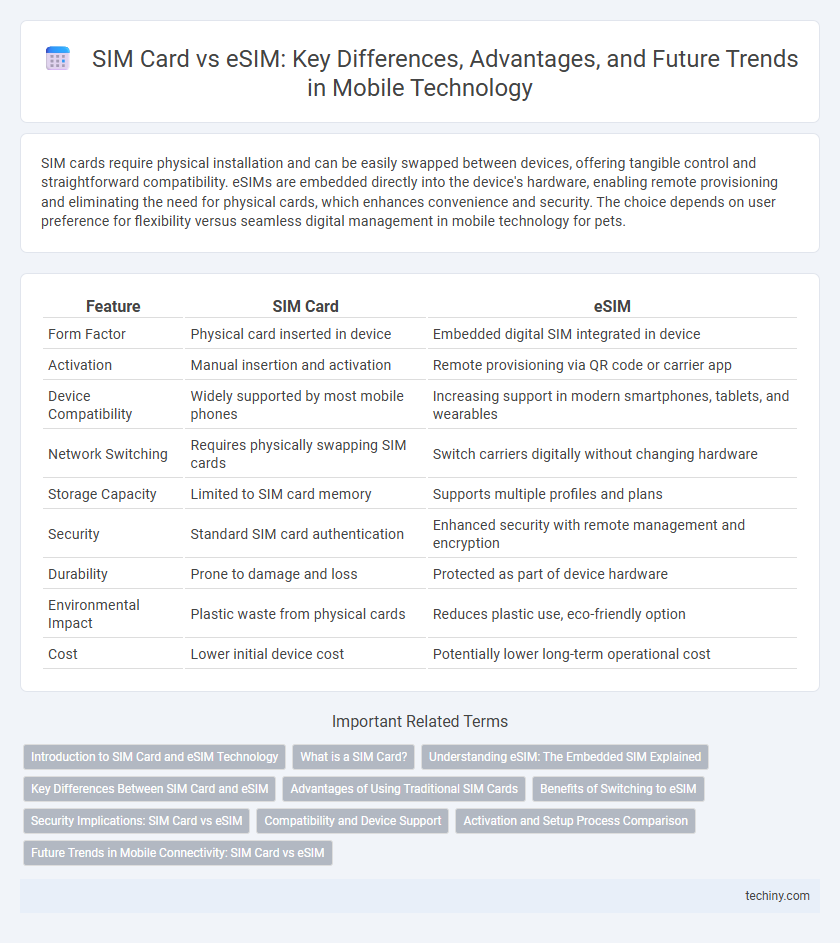SIM cards require physical installation and can be easily swapped between devices, offering tangible control and straightforward compatibility. eSIMs are embedded directly into the device's hardware, enabling remote provisioning and eliminating the need for physical cards, which enhances convenience and security. The choice depends on user preference for flexibility versus seamless digital management in mobile technology for pets.
Table of Comparison
| Feature | SIM Card | eSIM |
|---|---|---|
| Form Factor | Physical card inserted in device | Embedded digital SIM integrated in device |
| Activation | Manual insertion and activation | Remote provisioning via QR code or carrier app |
| Device Compatibility | Widely supported by most mobile phones | Increasing support in modern smartphones, tablets, and wearables |
| Network Switching | Requires physically swapping SIM cards | Switch carriers digitally without changing hardware |
| Storage Capacity | Limited to SIM card memory | Supports multiple profiles and plans |
| Security | Standard SIM card authentication | Enhanced security with remote management and encryption |
| Durability | Prone to damage and loss | Protected as part of device hardware |
| Environmental Impact | Plastic waste from physical cards | Reduces plastic use, eco-friendly option |
| Cost | Lower initial device cost | Potentially lower long-term operational cost |
Introduction to SIM Card and eSIM Technology
SIM cards are physical plastic cards that store subscriber information and enable network connectivity in mobile devices, traditionally used for identity verification and service authentication. eSIM technology, or embedded SIM, integrates the SIM functionality directly into the device's hardware, allowing remote provisioning and management without the need for a physical card. This shift enhances device design flexibility, simplifies carrier switching, and supports the growing demand for IoT connectivity by enabling multiple profiles on a single embedded module.
What is a SIM Card?
A SIM card, or Subscriber Identity Module, is a small, removable chip that stores essential data such as the user's phone number, network authentication information, and contact details, enabling cellular network connectivity. Traditional SIM cards must be physically inserted into a device, allowing users to switch phones by transferring the card. Unlike eSIMs, SIM cards are tangible hardware components that provide secure access to mobile networks and customer identity management.
Understanding eSIM: The Embedded SIM Explained
eSIM, or Embedded SIM, is a digital SIM technology integrated directly into a device, eliminating the need for a physical SIM card. It enables seamless switching between carriers and plans through software, enhancing flexibility for mobile users. This innovation supports remote provisioning and improves device design by saving physical space previously occupied by traditional SIM cards.
Key Differences Between SIM Card and eSIM
SIM cards are physical chips inserted into mobile devices to connect to cellular networks, whereas eSIMs are embedded digital chips that can be programmed remotely. Unlike traditional SIM cards, eSIMs offer enhanced flexibility by allowing multiple carrier profiles without the need to swap cards physically. Security and durability are improved in eSIM technology, as it eliminates the risk of losing or damaging the physical card.
Advantages of Using Traditional SIM Cards
Traditional SIM cards offer widespread compatibility with most mobile devices and provide a simple physical mechanism for managing mobile network access. Users benefit from the ease of swapping SIM cards between devices without requiring technical setup, enhancing flexibility for international travel or device upgrades. The physical nature of SIM cards also supports secure, offline access to carrier services and straightforward network identification.
Benefits of Switching to eSIM
Switching to eSIM offers enhanced convenience by eliminating the need for physical SIM cards, allowing users to activate multiple mobile plans digitally without changing hardware. eSIM technology supports faster carrier switching and international roaming with seamless profile downloads, reducing downtime and improving connectivity. Security is increased as eSIMs are embedded within devices, minimizing risks of SIM card theft or loss and enabling remote management for better user control.
Security Implications: SIM Card vs eSIM
Traditional SIM cards store user credentials on a physical chip, making them vulnerable to theft or cloning if the card is lost or stolen. eSIM technology embeds the subscriber identity within the device's hardware, enhancing security by enabling remote provisioning and reducing risks associated with physical tampering. Security protocols in eSIMs support encrypted authentication processes, offering stronger protection against SIM swapping attacks compared to conventional SIM cards.
Compatibility and Device Support
SIM cards offer broad compatibility with most mobile devices globally, including older smartphones, feature phones, and tablets, ensuring seamless network access. eSIM technology, while gaining rapid adoption in newer smartphones, smartwatches, and IoT devices, requires devices specifically designed with embedded chip support, limiting compatibility with older hardware. Leading manufacturers like Apple, Samsung, and Google prioritize eSIM integration in flagship models, accelerating device support but necessitating updated carrier infrastructure for optimal functionality.
Activation and Setup Process Comparison
SIM cards require physical insertion and manual activation through carrier settings, often involving visiting a store or entering activation codes. eSIMs enable remote provisioning via QR codes or carrier apps, allowing instant activation without needing a physical SIM swap. This streamlined setup of eSIMs enhances convenience and supports multiple profiles on a single device, contrasting with the traditional SIM's manual and hardware-dependent process.
Future Trends in Mobile Connectivity: SIM Card vs eSIM
The future of mobile connectivity is rapidly shifting towards eSIM technology, offering enhanced flexibility, remote provisioning, and improved device design compared to traditional SIM cards. eSIM adoption is expected to accelerate with the rise of IoT devices, 5G networks, and multi-device ecosystems, enabling seamless network switching and reduced reliance on physical SIM infrastructure. Mobile carriers and manufacturers are investing heavily in eSIM standards to support global interoperability and provide users with more dynamic, secure, and efficient mobile connectivity solutions.
SIM card vs eSIM Infographic

 techiny.com
techiny.com